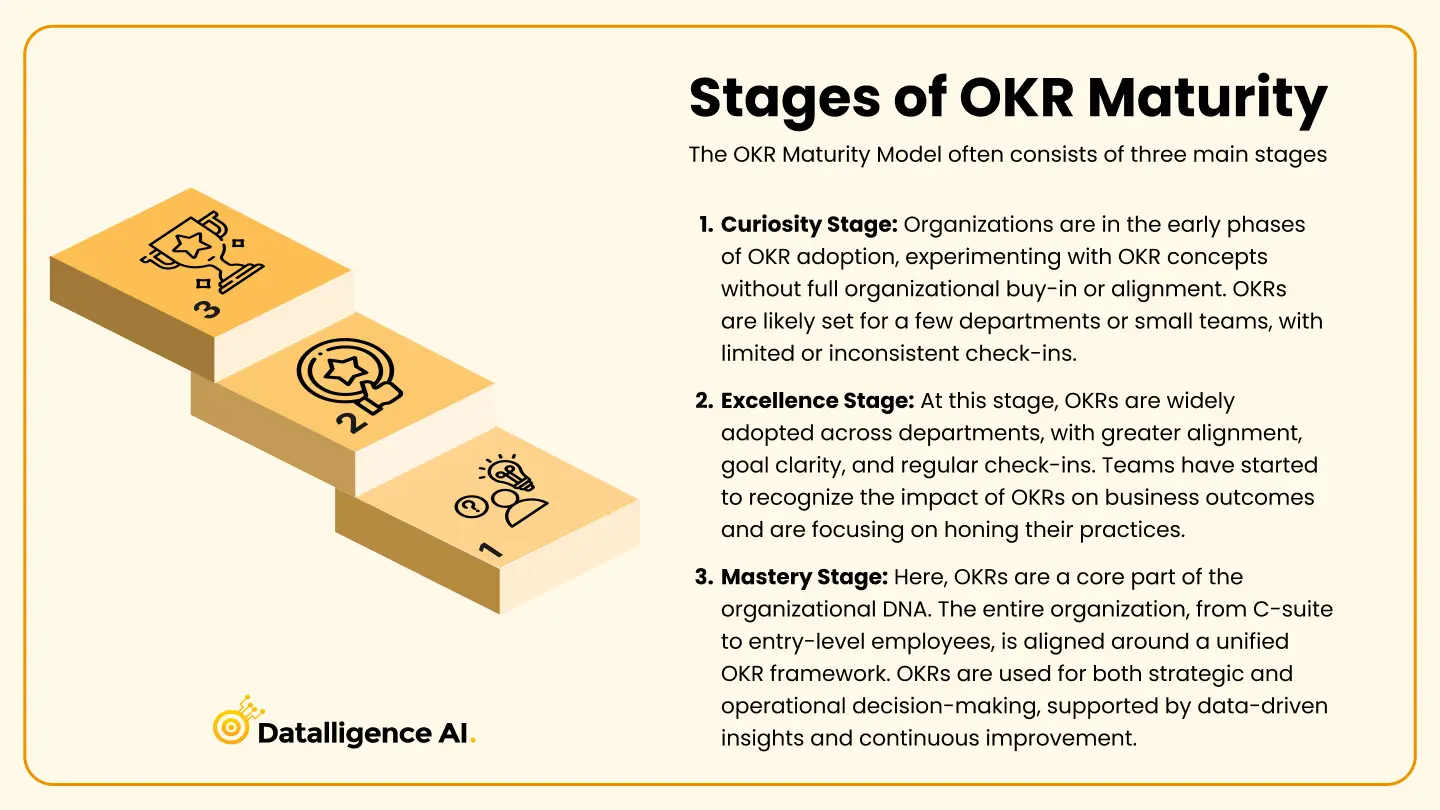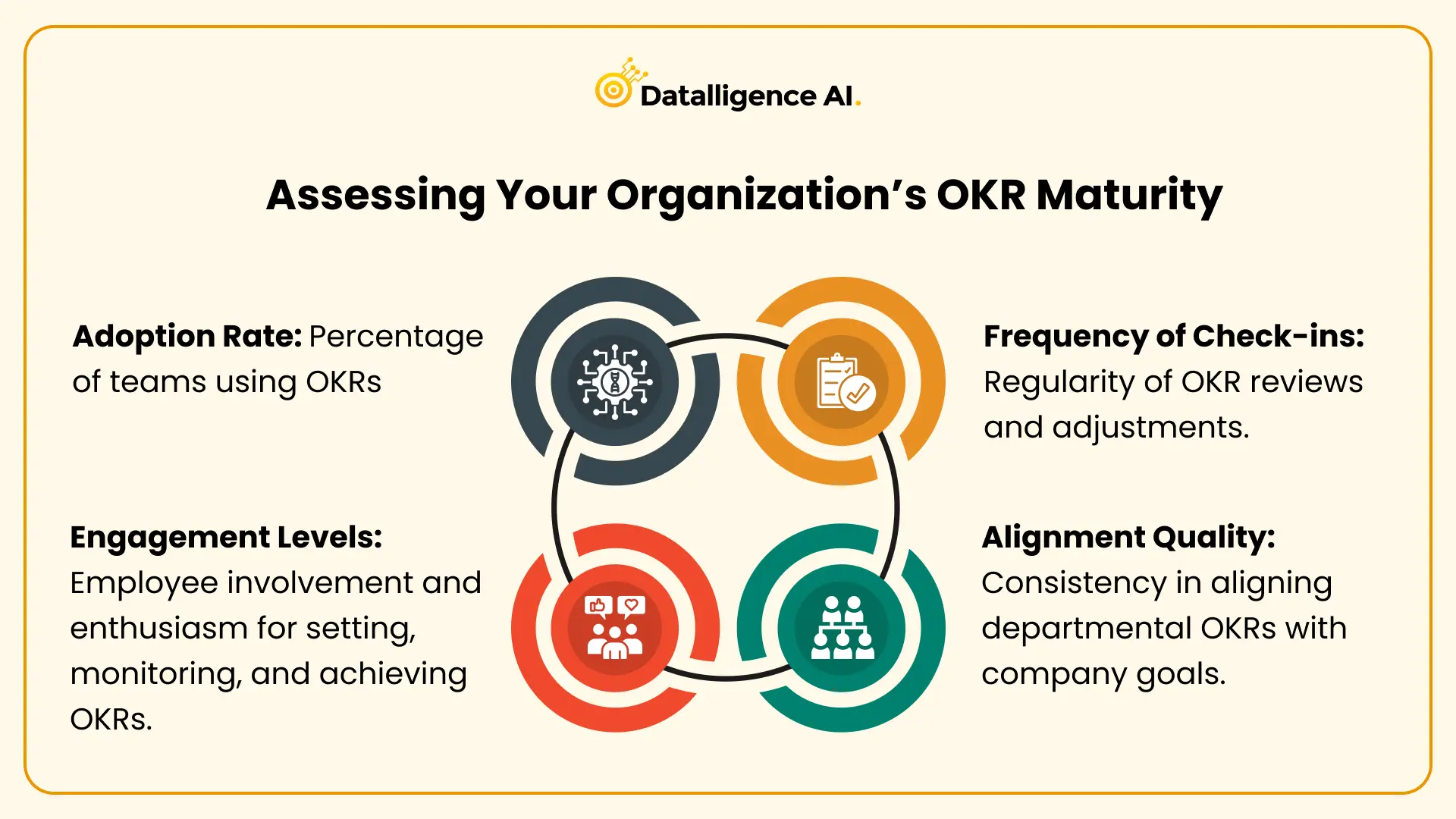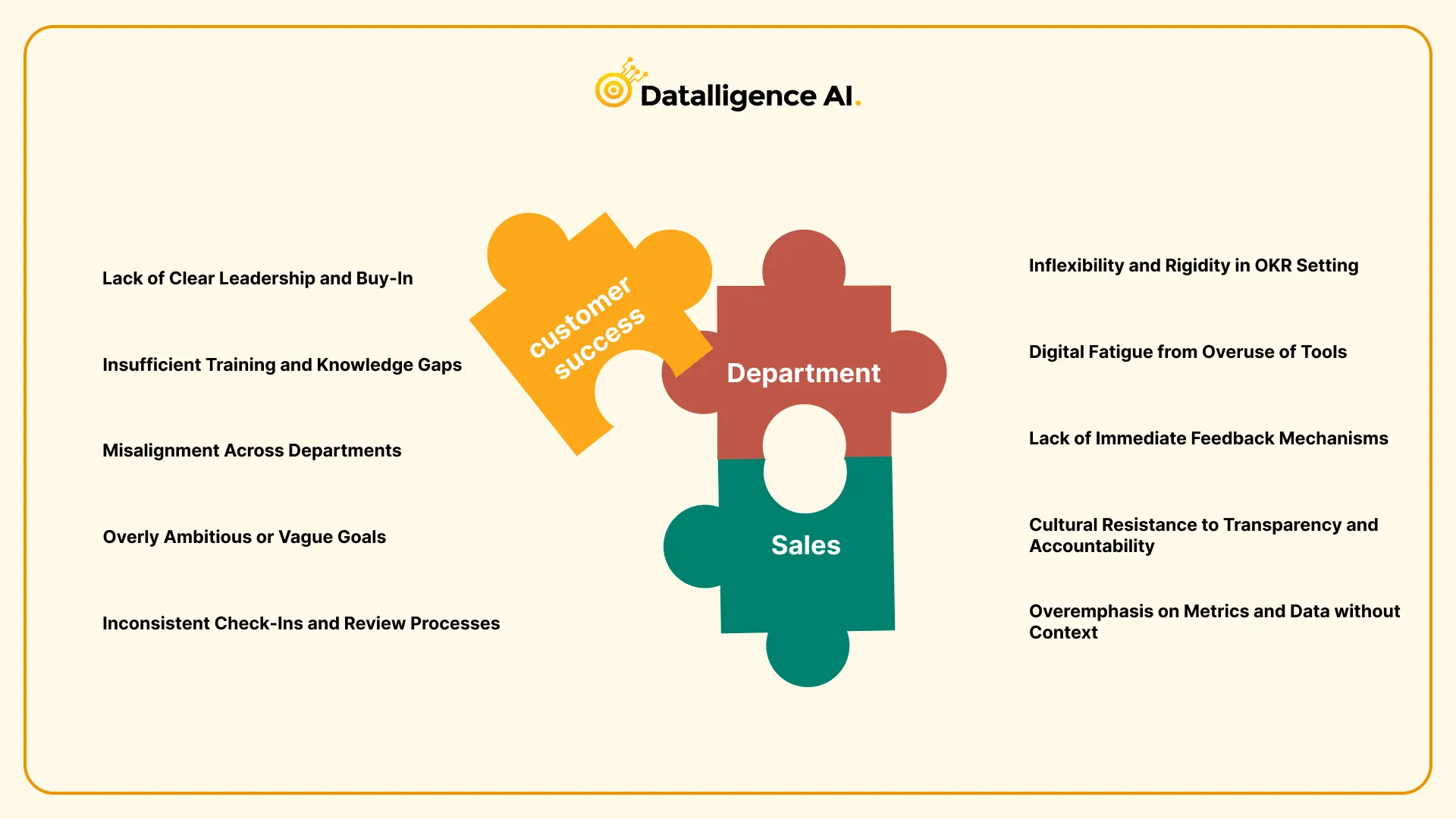In a world where clarity and alignment can make or break success, OKRs—Objectives and Key Results—have become indispensable. When paired with powerful OKR software, they do more than set goals; they connect strategy to daily work, turning aspirations into actionable targets that boost alignment and accountability across teams. But implementing OKRs is only half the journey. The OKR Maturity Model serves as a roadmap for organizations to assess and elevate their OKR practices, moving from basic goal-setting to full strategic alignment. For companies committed to leveling up, understanding this model is a game-changer, paving the way for lasting impact and growth.
Objectives and Key Results (OKRs) have become an essential tool for modern organizations, helping to translate strategic objectives into actionable steps that drive alignment, accountability, and performance. However, simply implementing OKRs does not guarantee success. The OKR Maturity Model provides a structured approach to gauge how well OKRs are embedded within an organization and offers a roadmap to advance through levels of OKR proficiency. Understanding and leveraging this model can be transformative for companies seeking to elevate their goal-setting approach and align their teams for strategic impact.
Definition and Importance of the OKR Maturity Model
The OKR Goal setting Maturity Model assesses an organization’s ability to implement, integrate, and leverage OKRs effectively. By identifying specific stages of maturity, this model guides companies in progressively advancing their OKR practices, from basic understanding to complete integration with strategic decision-making.
Why is it crucial? Organizations often struggle with sustained OKR adoption. The maturity model helps identify current strengths, reveals gaps, and points out areas for improvement, making it easier for teams to set realistic expectations for growth and measurable success. The end goal is a high-performing organization where OKRs serve as a powerful tool for driving alignment, enhancing visibility, and fostering a performance-oriented culture.
Historical Context: The Evolution of OKRs and Maturity Models
OKRs emerged in the 1950s through Peter Drucker’s “Management by Objectives” (MBO) and were later adapted by Andy Grove at Intel, becoming popular through John Doerr’s advocacy at Google. As OKRs gained global traction, organizations realized that effective OKR adoption was a journey. Thus, the OKR Maturity Model evolved to guide companies through a phased progression of learning, adopting, and mastering OKRs as a strategic discipline.
Stages of OKR Maturity
The OKR Maturity Model often consists of three main stages:

Characteristics of Each Stage
- Curiosity: Defined by learning, experimentation, and frequent revisions. Goals might lack precision, and alignment between teams may be weak. Check-ins may be irregular, leading to low engagement and sporadic accountability.
- Excellence: OKRs gain greater clarity and relevance to business outcomes. There’s consistent cross-functional collaboration, and OKR check-ins occur more frequently. Teams have started aligning their departmental OKRs with broader company objectives, though they may still require refinement.
- Mastery: OKRs are seamlessly embedded within strategic and operational activities. Alignment is high, with data analytics and dashboards driving real-time performance tracking. Goals can evolve flexibly to respond to market changes, and OKRs are part of an established culture of accountability and achievement.
Organizations can self-assess their maturity level by evaluating consistency in OKR usage, the quality of cross-functional alignment, and the extent of integration with other business processes.
Assessing Your Organization’s OKR Maturity
Assessing your organization’s OKR maturity involves examining the consistency, quality, and integration of OKRs. Self-assessment tools like maturity scorecards, surveys, and audits are useful for pinpointing your current stage. Some recommended assessment areas include:

Organizations can identify improvement areas and formulate action plans tailored to their maturity stage using these metrics.
Common Challenges in OKR Maturity and How to Overcome Them
Each stage of maturity comes with its own set of challenges:
- Curiosity Stage Challenges: Resistance to change, lack of clarity on OKRs, and minimal engagement.
- Excellence Stage Challenges: Inconsistent alignment across teams, rigid OKR setting, and limited feedback loops.
- Mastery Stage Challenges: Difficulty maintaining adaptability and engaging all employees in OKR ownership.
Strategies for Advancing Through the Stages
Organizations seeking to advance their OKR maturity can benefit from specific, actionable steps:
- Curiosity to Excellence: Focus on consistent education and awareness. Establish basic OKRs and pilot them in one or two departments. Regularly communicate successes and learnings.
- Excellence to Mastery: Emphasize data-driven insights, integrate OKRs with performance management, and nurture strategic thinking skills. Train employees on advanced OKR techniques and foster a cross-functional alignment culture.
Case Study Example: For instance, a tech startup initially implemented OKRs within its product team. After realizing the potential for alignment and efficiency, they expanded OKRs to marketing and sales teams, bridging gaps and improving collaboration, eventually reaching the Mastery stage where OKRs defined their strategic focus.
The Role of Leadership in OKR Maturity
Leadership plays a critical role in the successful adoption and maturation of OKRs. Without top-level buy-in, OKRs can become another task rather than a powerful tool for transformation.
- Leadership Commitment: Leaders should actively demonstrate their support, set OKRs themselves, and encourage transparency throughout the organization. This sets a tone of accountability and openness.
- Training and Development: Regular OKR workshops, skill-building sessions, and open forums help employees understand OKR philosophy and effectively contribute to setting and achieving OKRs.
Measuring Success in OKR Implementation
Tracking the success of your OKR program is essential. Key performance indicators (KPIs) are invaluable for assessing how well OKRs drive organizational goals:
- Achievement Rate: Track the percentage of OKRs met each quarter.
- Alignment and Engagement Scores: Measure alignment between departmental and organizational OKRs, as well as employee participation in the OKR process.
- Feedback Loops: Establish structured feedback sessions to gather insights and continuously refine the OKR process.
Integrating OKRs into Organizational Culture
Building a culture around OKRs means promoting transparency, alignment, and learning.
- Cultural Shifts: Leaders should model behaviors that promote OKR alignment, creating a transparent environment where progress and challenges are openly shared.
- Engagement Strategies: Use initiatives to involve employees in OKR discussions and showcase how OKRs impact their roles. By creating a sense of ownership and purpose, you foster greater buy-in.
Common Roadblocks in Implementing the OKR Maturity Model

- Lack of Clear Leadership and Buy-In – When leadership is not fully engaged or committed to OKR adoption, employees are less likely to prioritize OKRs, viewing them as just another management fad.
- Insufficient Training and Knowledge Gaps- OKRs often fail when employees don’t fully understand the purpose, structure, or best practices for setting and tracking them. This can lead to poorly defined objectives and key results, reducing their effectiveness
- Misalignment Across Departments – Lack of cross-departmental alignment can cause teams to set conflicting or redundant OKRs, reducing the overall effectiveness of OKRs.
- Overly Ambitious or Vague Goals – Inexperienced teams often set OKRs that are either too ambitious or too vague, leading to frequent misses or lack of measurable progress.
- Inconsistent Check-Ins and Review Processes – Regular check-ins are essential for OKR success, yet many organizations fail to maintain consistency. Without regular reviews, OKRs can lose relevance or momentum.
- Inflexibility and Rigidity in OKR Setting – OKRs require adaptability, especially in fast-changing environments. Rigid OKR setting processes can hinder teams from pivoting when market or organizational conditions change.
- Digital Fatigue from Overuse of Tools – Too many tools or cumbersome OKR software can lead to digital fatigue, causing teams to disengage from the OKR process.
- Lack of Immediate Feedback Mechanisms – Without feedback, employees don’t receive real-time insights or recognition for their progress, which can lead to disengagement.
- Cultural Resistance to Transparency and Accountability – In some organizations, employees may be uncomfortable with the level of transparency and accountability that OKRs require, especially if the culture has historically focused on individual performance.
- Overemphasis on Metrics and Data without Context – Organizations sometimes focus heavily on achieving OKR metrics, overlooking qualitative insights and context that matter for genuine growth.
Future Trends in OKRs
As businesses evolve, so will OKRs. Emerging practices in AI, automation, and remote work are reshaping the future of OKRs:
- Emerging Practices: Automated insights and nudges help employees stay aligned, while OKR management platforms now offer predictive analytics for proactive decision-making.
- Impact of Remote Work: Remote work underscores the need for asynchronous communication and transparent OKR processes, enabling teams to remain aligned regardless of physical location.
Conclusion
The OKR Maturity Model provides a structured approach for organizations seeking to optimize their performance and goal-setting practices. By understanding the stages of maturity, evaluating their current state, and taking actionable steps to advance, organizations can transform their OKR journey from a basic framework into a core driver of success.










